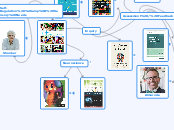Neuroscience

The Brain in MindPg 23 - sensory input, sensory motor developmentPg 43 - time schedule for complex learningPg 45 - value of prior knowledgePg 55 - feedbackPg64, 66 - weaving math, geo, social skills, role play,science, phys ed togetherPg 95 - social brainPg 103 - demotivationPg 107-109 states of motivationPg 116-118 problem solvingPg 121 - direct link btwn understanding emotional states and ability to think critically***EMOTIONAL STATESPg 55-56Pg 68-78 ***

Inquiry

The Runaway Species: How Human Creativity Remakes the WorldPg. 49 - 3 Bs of Creativity: bending, breaking, and blending - a way of capturing the brain operations that underlie innovative thinking Pg. 170 - “As weve seen, theres a pervasive problem in generating useful creations: you never know what the world needs and how it will receive it. The person who only tinkers with prior art may be weak on breakthrough, while the person who dives full-time into time machines and underwater stadiums may never develop the competencies to realize a vision. Instead of remaining at a fixed distance, an optimal strategy is to generate a range of ideas, some of which stay closer to home, while others fly further.” - BALANCEPG 206 “Overly rigid habits and conventions, no matter how well considered or well intentioned, threaten innovation”Pg 209 -”the goal of a creative corporation is to escape repetition suppression, proliferate options and disrupt whats working well before it wears out its welcome. Innovation is energized by upsetting routine”Its about the constant change rather than the open collaborative space“IDEA QUOTAS” Pg 213 “this is why generating lots of ideas has to be a goal. Thomas edison set “idea quotas” for his employees: they were challenged to come up with one small invention per week and a major breakthrough every six months”Pg 216 “an education in creativity lies in the sweet spot btwn unstructured play and imitating models. This sweet spot gives the students precedents to build on but it doesnt condition or constrain their choices”Pg 220 proliferate choices:”too often, when we ask students for creative output we are satisfied with a single solution. But with only one answer - no matter how good - an inventive mnd is simply getting warmed up. The best practice in as classroom is to require students to generate not just one solution to a creative problem, but many” “proliferating options also gives students an appreciation for the natural diversity they see in the world around them”Pg 225 “a sandboxing approach can be applied to creative assignments: students are asked to come up with multiple options for something creative, but these arent graded, just reviewed. The student then picks her fav to develop to completion. This not only enourages students to proliferate options, it also gives an opportunity to take chances without penalty. Often, risk taking involves walking the high wire of a problem without the safety net of an answer key. Any problem with an open outcome promotes risk taking: its up to students to find their own way”Pg. 232 “the more children do the making in their classrooms, the more they see themselves as makers of their own world. Thats the goal of creative schooling. Things come alive in the classroom when precedent is presented notas the answer but as the springboard. Get you Ss to proliferate options instead of coming up with single solution. Inspire them to take risks instead of taking safe route. Motivate and encourage your Ss, whether from inside (meaningful challenges) or outside (audiences and rewards). A curriculum that fosters creative thinking makes our young not just tourists of the imagination, but guides.”


Assessment / Feedback

Lifelong Kindergarten: Cultivating Creativity through Projects, Passion, Peers and PlayPg 91 “when people think about thinking, they often think of Rodin’s famous sculpture The Thinker, which shows a lone individual, sitting by himself, in deep contemplation... [But] most of the time thinking is integrated with doing: we think in the context of interacting with things, playing with things, creating things. And most thinking is done in connection with other people: we share ideas, get reactions from other people, build upon each others ideas”Pg 112-113 teacher as catalyst, consultant, connector and collaborator…Pg 127 “ play doesnt require open spaces or expensive toys: it requires a combination of curiosity, imagination, and experimentation”Pg 130 types of play “what types of play are most likely to help young people develop as creative thinkers? And how can we best encourage and support those types of play?”Pg 132 “we want kids to experience the challenges and joys of turning their own ideas into projects.”Pg 136 “tinkerers understand how to improvise, adapt, and iterate, so they’re never hung up on old plans as new situations arise. Tinkering breeds creativity”Pg 137 “ tinkerers believe in rapid prototyping and iteration” extended -go seePg 139 wide walls, low floor (multiple entry pts), high ceiling (more sophisticated, build upon)Pg 141 types of play: patternists & dramatistsPg 144 “we should push learners to reach outside their comfort zone. For certain types of problems, planning has advantages over tinkering: for other types of problems, tinkering has advantages.” ie exploring patterns...telling stories.. Etc. depends on situationPg 151 “schools dont know how to measure creative thinking, so they end up measuring things that they can measure easily” - distorts practice“In todays data obsessed world some people think that everything can be quantitatively measured, if we just figure out the right data to collect.152 “if we want to support things that are the most valuable and important (such as creative thinking and the joy of learning), we need to broaden our view of evidence. Rather than just trying to measure what children learn (through numbers), we also need to document what children learn (through compelling examples) *WHAT IS EVIDENCE?Pg 168 “they key challenge is not how to “teach creativity” to children, but rather how to create a fertile environment in which their creativity will take root, grow and flourish”Pg 171 PLAY: EXTENDED TIME FOR PROJECTS “trying to squeeze projects into the constraints of standard 50 min period - or even a few 50 min periods - undermines the whole idea of working on prjects. It discourages risk taking and experimentation, and puts priority on “right” answer within allotted time.” for change, schedule double periods for projects.. Set aside days or even weeks (or months) for projects *large blocks of timePg 180 “to meet the needs of a creative society, we need to break down many structural barriers in the educational system. We need to break down barriers across disciplines, providing students with opportunities to work on projects that integrate multiple subject areas. We need to break down barriers across age, allowing people of all ages to work with and from one another. We need to break down barriers across space, connecting activities in schools, community centres and homes. And we needto break down break down barriers across time, enabling children to work on interest-based projects for weeks or months or years, rather than squeezing projects into the constraints of a class period or curriculum unit


Almarode
Almarode - Assessment (from lecture Apr 5)Three questions students should ask themselves every day:What am I learning? Why am I learning it?How do I know I’ve learned it? (what does success look like)OTF project - are missing last point, we need to create criteria for students “I can self regulate because…” need to have clear criteria so students can then reflect and input info into portfolioIMPACT of student learning - can be small, moderate, huge - we need to look for how to make the large impact (everyone feels it)1. Clarity (when both students and teachers can clearly answer those 3 questions)What is an assessment capable learner?Six characteristics: What they understand & What they dont understandtheir next stepsTools to select to take next stepConstantly want feedbackMonitor own progress Recognize own learningHelp othersAssessment Capable Visible Learners bookResearch supports PROXIMAL next steps not far awaySelf regulation in an academic contextRun this parallel with self reg of emotions/behaviour (go hand in hand)Should help build self efficacy around these skills in order for them to help othersIn terms of learning, FEEDBACK is more important - addresses where are my learners, and where I want them to go - the GAPStop grading!We don’t tell them the answer/hot to do it, we tell them where to go to be able to self-assess and self-monitor (give them the guidance to do it - prompting!)Help them see where they are, where they’re going and what they can do to close the gapIf we do this, we are building assessment capable learnersWe purposefully let them know the learning intention, purposefully let them choose strategiesFour years worth of learning in one year For inquiry to work, all three for as and of need to be thereWhat do they need to master? Did they master the content?OF- masteryFOR- things we put in place daily to monitor learning - are they progressing in the learning as they AS- scaffolding, to engage throughout

Hattie
Self-Regulation & Sensory Needs

Shanker
Professional Development

